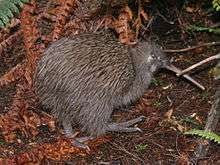New Zealand grebe
| New Zealand grebe | |
|---|---|
 | |
| Scientific classification | |
| Kingdom: | Animalia |
| Phylum: | Chordata |
| Class: | Aves |
| Order: | Podicipediformes |
| Family: | Podicipedidae |
| Genus: | Poliocephalus |
| Species: | P. rufopectus |
| Binomial name | |
| Poliocephalus rufopectus (Gray, 1843) | |
The New Zealand grebe, New Zealand dabchick, or weweia (Poliocephalus rufopectus) is a member of the grebe family endemic to New Zealand. This species was formerly present in the lowland lakes of the South Island,[2] but underwent a rapid decline there (for unknown reasons) in the 19th century- the last certain breeding record for this species in the South Island was in 1941.[3] In the North Island it is found on the West coast on coastal lakes from North Cape to Pukekohe and from Southern Taranaki to Paraparaumu, on lakes of the central plateau, Gisborne, Hawkes bay and the Wairarapa.[3]
Description
The New Zealand grebe has dark brown plumage, black back and a pale yellow iris. It grows to a size of about 29 centimeters, and a weight of about 250 grams.[3] Females tend to be lighter than their male counterparts.[4]
Diet
Their diet consists mostly aquatic insects and their larvae, as well as small mollusks such as freshwater snails.[2] Bigger prey such as fish and freshwater crayfish are sometimes taken.[3]
References
- ↑ BirdLife International (2015). "Poliocephalus rufopectus". IUCN Red List of Threatened Species. Version 2015. International Union for Conservation of Nature. Retrieved 24 January 2016.
- 1 2 Andrew Crowe, "Which New Zealand Bird?", Penguin, 2001
- 1 2 3 4 Barrie Heather and Hugh Robertson, "The Field Guide to the Birds of New Zealand (revised edition)", Viking, 2005
- ↑ Marchant, S.; Higgins, P.J. (Eds.) (1990). Handbook of Australian, New Zealand & Antarctic Birds. Volume 1, Ratites to ducks; Part A, Ratites to petrels. Melbourne: Oxford University Press. p. 107.

